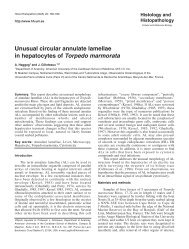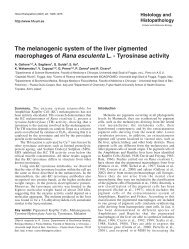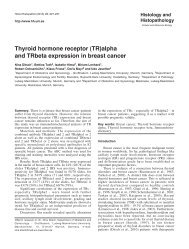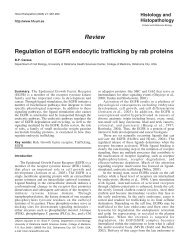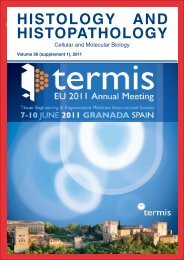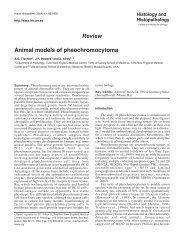Review Multicolor FISH probe sets and their applications
Review Multicolor FISH probe sets and their applications
Review Multicolor FISH probe sets and their applications
You also want an ePaper? Increase the reach of your titles
YUMPU automatically turns print PDFs into web optimized ePapers that Google loves.
232<br />
<strong>Multicolor</strong> <strong>FISH</strong> <strong>probe</strong> <strong>sets</strong><br />
conserved ones on chromosomes 13 <strong>and</strong> 21 in one single<br />
step by individual pseudo-coloring (see Fig. 4).<br />
III. For the characterization of the short arms <strong>and</strong> the<br />
centromeric regions of the acrocentric chromosomes two<br />
similar <strong>probe</strong> <strong>sets</strong> are available: the acroM-<strong>FISH</strong><br />
(Langer et al., 2001) <strong>and</strong> the acro-cenM-<strong>FISH</strong> (see Fig. 5<br />
(Trifonov et al., 2003)) <strong>probe</strong> <strong>sets</strong>.<br />
IV. Subcentromere-specific multicolor <strong>FISH</strong><br />
(subcenM-<strong>FISH</strong>) is again a recently described m<strong>FISH</strong><br />
<strong>probe</strong> set ((Starke et al., 2002) - see Fig. 6) which<br />
specifically paints a chromosomal region that not all<br />
other available <strong>FISH</strong> or m<strong>FISH</strong> <strong>probe</strong> <strong>sets</strong> can<br />
characterize: centromere near euchromatic material. This<br />
is due to the fact that these regions are either overlaid by<br />
a flaring effect of the fluorescence-intense centromeric<br />
signals, or underrepresented in other chromosome or<br />
chromosome-region-specific <strong>probe</strong>s.<br />
V. The extreme ends of all vertebrate chromosomes<br />
consist of noncoding, t<strong>and</strong>emly repeated hexanucleotide<br />
units TTAGGG (5’→3’ direction), thus, the different<br />
human telomeres cannot be specifically stained using<br />
telomeric <strong>probe</strong>s (Blackburn <strong>and</strong> Greider, 1995).<br />
Therefore, <strong>and</strong> as subtelomeric sequences are often<br />
underrepresented in whole chromosome painting <strong>probe</strong>s,<br />
efforts have been made to develop an m<strong>FISH</strong> set<br />
consisting of subtelomeric <strong>probe</strong>s (Granzow et al., 2000;<br />
Brown et al., 2001).<br />
VI. Similar to the problems in clinical genetics<br />
which are addressed with the centromeric <strong>probe</strong>s in point<br />
I, locus-specific <strong>probe</strong>s were put together <strong>and</strong> are<br />
available commercially. Examples are (i) <strong>probe</strong> set kits<br />
for rapid prenatal diagnosis in uncultured amnion cells<br />
with the goal of a rapid interphase analysis for the most<br />
frequently occurring trisomies (#13, #21) (Eiben et al,<br />
1999; Thilaganathan et al., 2000), (ii) specific m<strong>FISH</strong><br />
assay for preimplantation diagnostics (Harper <strong>and</strong> Wells,<br />
1999) or (iii) special multitarget m<strong>FISH</strong> for interphase<br />
tumor cytogenetics (e.g. (Sokolova et al., 2000)).<br />
Applications of m<strong>FISH</strong> <strong>probe</strong> <strong>sets</strong><br />
The above mentioned <strong>probe</strong> <strong>sets</strong> are applied in<br />
prenatal or postnatal clinical genetics <strong>and</strong>/or tumor<br />
cytogenetics. Optimally, <strong>their</strong> use should be embedded<br />
into a strategy for the characterization of human<br />
(marker) chromosomes (Liehr <strong>and</strong> Claussen, 2002a).<br />
Nonetheless, each <strong>probe</strong> set has its own capacities <strong>and</strong><br />
limitations, which are discussed as follows.<br />
Whole chromosome painting m<strong>FISH</strong> <strong>probe</strong> <strong>sets</strong> have<br />
been successfully used for confirmation, refinement<br />
<strong>and</strong>/or characterization of translocations, search for<br />
cryptic rearrangements <strong>and</strong> characterization of marker<br />
chromosomes in clinical genetics, tumor cytogenetics,<br />
mutagenesis, radiobiology, evolution in mammals or<br />
interphase architecture (for overview of the<br />
corresponding literature see Liehr <strong>and</strong> Claussen,<br />
2002a,b; Liehr, 2003). As mentioned above, the whole<br />
chromosome painting m<strong>FISH</strong> <strong>probe</strong> set can be combined<br />
with additional <strong>probe</strong>s, according to the question in<br />
focus. If microdeletions (Tosi et al., 1999) or non-human<br />
DNA insertions shall be studied (Szuhai et al., 2000)<br />
single-copy <strong>probe</strong>s can be added in additional color<br />
combinations. For Zoo-<strong>FISH</strong> studies it turned out to be<br />
informative to additionally introduce a <strong>probe</strong> specific for<br />
the human acrocentric chromosome p-arms (Mrasek et<br />
al., 2001).<br />
m<strong>FISH</strong> methods using human whole chromosome<br />
painting <strong>probe</strong>s reach <strong>their</strong> limits when exact breakpoint<br />
localization of translocations are required, or in case of<br />
intrachromosomal rearrangements such as interstitial<br />
deletions or inversions. Thus, different <strong>probe</strong> <strong>sets</strong> have<br />
been developed to avoid missing substantial portions of<br />
inter- <strong>and</strong> intra-chromosomal aberrations in human<br />
Fig. 5. Labeling scheme <strong>and</strong> result of acro-cenM-<strong>FISH</strong> in a case with a<br />
NOR-positive supernumerary marker chromosome (SMC – marked by<br />
arrowheads). The acro-cenM-<strong>FISH</strong> <strong>probe</strong>-mix contains (i) a <strong>probe</strong><br />
specific for the acrocentric human p-arms (midi54), (ii) a NOR-specific<br />
<strong>probe</strong> (dJ1174A5), (iii) a <strong>probe</strong> specific for Yq12 (pLAY113.5), as well<br />
as (iv) the available centromere-specific <strong>probe</strong>s for all human<br />
acrocentrics (Trifonov et al., 2003). The acro-cenM-<strong>FISH</strong> results allow<br />
for a description of the SMC as an idic(15)(q?12).<br />
Fig. 6. Subcentromere-specific multicolor <strong>FISH</strong> (subcenM-<strong>FISH</strong>) was<br />
performed on the SMC characterized by acro-cenM-<strong>FISH</strong> in Fig. 5 –<br />
abbreviated as “dic(15)” in this figure. According to this result the SMC<br />
could be characterized as an idic(15)(q11.2-12). The applied subcenM-<br />
<strong>FISH</strong> <strong>probe</strong> set for chromosome 15 is specified in the left part of the<br />
figure: blue = midi54 (see Figs. 1 <strong>and</strong> 5); red = alpha-satellite <strong>probe</strong> for<br />
chromosome 15; white = centromere-near <strong>probe</strong> in 15q11.2<br />
(=bA171C8); <strong>and</strong> yellow = whole chromosome paint for chromosome<br />
15.



